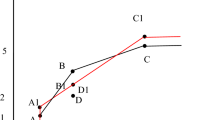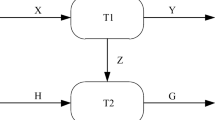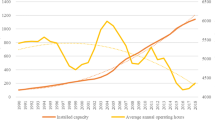Abstract
With the development of China’s economy, environmental pollution has become cumulatively serious. The primary source of environmental pollution is thermal power generation, which has attracted the attention of governments and academia in recent years. To effectively reduce environmental pollution, research should study how to constrain the undesirable output of thermal power plants, that is, to limit the total undesirable output of the plants to a certain fixed sum. However, few studies have suggested that these undesirable outputs should be fixed-sum outputs. Moreover, no previous research publication about thermal power plants has analyzed their environmental performance changes. To address these gaps, a novel Malmquist-DEA approach is proposed for evaluate the environmental performance of thermal power plants in this paper. This approach generalizes the equilibrium efficient frontier DEA model with fixed-sum undesirable outputs and incorporates the model into the Malmquist productivity index (MPI). The authors apply this approach to the analysis of provincial thermal power plant environmental performance in China and analyze such plants’ trends based on panel data from 2011 to 2014. The empirical research shows that the environmental performance of regional thermal power plants was positively affected by efficiency change and negatively affected by technical change. Finally, the authors provide policy suggestions based on our findings.
Similar content being viewed by others
References
Wang K, Yu S, and Zhang W, China’s regional energy and environmental efficiency: A DEA window analysis based dynamic evaluation, Mathematical and Computer Modelling, 2013, 58(5–6): 1117–1127.
Wu J, Zhu Q Y, Chu J F, et al., Two-stage network structures with undesirable intermediate outputs reused: A DEA based approach, Computational Economics, 2015, 46(3): 455–477.
Wu J, Zhu Q Y, Yin P Z, et al., Measuring energy and environmental performance for regions in China by using dea-based malmquist indices, Operational Research, 2017, 17(3): 715–735.
Wu J, Zhu Q Y, and Liang L, CO2 emissions and energy intensity reduction allocation over provincial industrial sectors in China, Applied Energy, 2016, 166: 282–291.
Liu X, Zhu Q Y, Chu J F, et al., Environmental performance and benchmarking information for coal-fired power plants in China: A DEA approach, Computational Economics, 2019, 54(4): 1287–1302.
Song M L, Zheng W P, and Wang S H, Measuring green technology progress in large-scale thermoelectric enterprises based on Malmquist-Luenberger life cycle assessment, Resources, Conservation and Recycling, 2017, 122: 261–269.
Wu J, Xia P P, Zhu Q Y, et al., Measuring environmental efficiency of thermoelectric power plants: A common equilibrium efficient frontier DEA approach with fixed-sum undesirable output, Annals of Operations Research, 2019, 275(2): 731–749.
Charnes A, Cooper W W, and Rhodes E, Measuring the efficiency of decision making units, European Journal of Operational Research, 1978, 2(6): 429–444.
Cook W D and Seiford L M, Data envelopment analysis (DEA)-thirty years on, European Journal of Operational Research, 2009, 192(1): 1–17.
An Q X, Wang Z R, Emrouznejad A, et al., Efficiency evaluation of parallel interdependent processes systems: An application to Chinese 985 project universities, International Journal of Production Research, 2019, 57(17): 5387–5399.
Li F, Zhu Q Y, and Chen Z, Allocating a fixed cost across the decision making units with two-stage network structures, Omega, 2019, 83: 139–154.
Lozano S, Villa G, and Eguía I, Data envelopment analysis with multiple modes of functioning. application to reconfigurable manufacturing systems, International Journal of Production Research, 2017, 55(24): 7566–7583.
Wang C H and Chien Y W, Combining balanced scorecard with data envelopment analysis to conduct performance diagnosis for taiwanese led manufacturers, International Journal of Production Research, 2016, 54(17): 5169–5181.
An Q X, Chen H X, Wu J, et al., Measuring slacks-based efficiency for commercial banks in china by using a two-stage dea model with undesirable output, Annals of Operations Research, 2015, 235(1): 13–35.
Kong W H, Fu T T, and Yu M M, Evaluating taiwanese bank efficiency using the two-stage range dea model, International Journal of Information Technology & Decision Making, 2017 16(4): 1043–1068.
Wang K, Huang W, Wu J, et al., Efficiency measures of the Chinese commercial banking system using an additive two-stage DEA, Omega, 2014, 44: 5–20.
Emrouznejad A and Yang G L, A survey and analysis of the first 40 years of scholarly literature in DEA: 1978–2016, Socio-Economic Planning Sciences, 2018, 61: 4–8.
Shang J K, Hung W T, Lo C T, et al., Ecommerce and hotel performance: Three-stage dea analysis, The Service Industries Journal, 2008, 28(4): 529–540.
Wu J, Lu X, Guo D, et al., Slacks-based efficiency measurements with undeirable outputs in data envelopment analysis, International Journal of Information Technology & Decision Making, 2017, 16(4): 1005–1021.
Xie Q W, Hu P, Jiang A, et al., Carbon emissions allocation based on satisfaction perspective and data envelopment analysis, Energy Policy, 2019, 132: 254–264.
Gu W, Basu M, Chao Z, et al., A unified framework for credit evaluation for internet finance companies: Multi-criteria analysis through AHP and DEA, International Journal of Information Technology & Decision Making, 2017, 16(3): 597–624.
Krmac E and Djordjević B, A multi-criteria decision-making framework for the evaluation of train control information systems, the case of ERTMS, International Journal of Information Technology & Decision Making, 2019, 18(1): 209–239.
Färe R, Grosskopf S, Lovell C K, et al., Multilateral productivity comparisons when some outputs are undesirable: A nonparametric approach, The Review of Economics and Statistics, 1989, 71(1): 90–98.
Bian Y W and Yang F, Resource and environment efficiency analysis of provinces in China: A DEA approach based on shannons entropy, Energy Policy, 2010, 38(4): 1909–1917.
Dai X F and Kuosmanen T, Best-practice benchmarking using clustering methods: Application to energy regulation, Omega, 2014, 42(1): 179–188.
Li H and Shi J F, Energy efficiency analysis on Chinese industrial sectors: An improved super-sbm model with undesirable outputs, Journal of Cleaner Production, 2014, 65: 97–107.
Song M L, An Q X, Zhang W, et al., Environmental efficiency evaluation based on data envelopment analysis: A review, Renewable and Sustainable Energy Reviews, 2012, 16(7): 4465–4469.
Suzuki S and Nijkamp P, An evaluation of energy-environment-economic efficiency for EU, APEC and ASEAN countries: Design of a target-oriented dfm model with fixed factors in data envelopment analysis, Energy Policy, 2016, 88: 100–112.
Wu J, Zhu Q Y, Chu J F, et al., Measuring energy and environmental efficiency of transportation systems in China based on a parallel DEA approach, Transportation Research Part D: Transport and Environment, 2016, 48: 460–472.
Zhou P, Poh K L, and Ang B W, A non-radial DEA approach to measuring environmental performance, European Journal of Operational Research, 2007, 178(1): 1–9.
Korhonen P J and Luptacik M, Eco-efficiency analysis of power plants: An extension of data envelopment analysis, European Journal of Operational Research, 2004, 154(2): 437–446.
Sueyoshi T, Goto M, and Ueno T, Performance analysis of us coal-fired power plants by measuring three dea efficiencies, Energy Policy, 2010, 38(4): 1675–1688.
Sueyoshi T and Goto M, Efficiency-based rank assessment for electric power industry: A combined use of data envelopment analysis (DEA) and dea-discriminant analysis (DA), Energy Economics, 2012, 34(3): 634–644.
Song M L, Peng J, and Wu Q Q, An undesirable-output-considered super-efficiency dea model and its illustration in evaluation of thermoelectric enterprises, Journal of Intelligent & Fuzzy Systems, 2014, 27(3): 1507–1517.
Wu J, Xiong B B, An Q X, et al., Measuring the performance of thermal power firms in China via fuzzy enhanced russell measure model with undesirable outputs, Journal of Cleaner Production, 2015, 102: 237–245.
Arabi B, Doraisamy S M, Emrouznejad A, et al., Eco-efficiency measurement and material balance principle: An application in power plants Malmquist Luenberger Index, Annals of Operations Research, 2017, 255(1–2): 221–239.
Lins M P E, Gomes E G, de Mello J C C S, et al., Olympic ranking based on a zero sum gains DEA model, European Journal of Operational Research, 2003, 148(2): 312–322.
Yang F, Wu D D, Liang L, et al., Competition strategy and efficiency evaluation for decision making units with fixed-sum outputs, European Journal of Operational Research, 2011, 212(3): 560–569.
Yang M, Li Y J, Chen Y, et al., An equilibrium efficiency frontier data envelopment analysis approach for evaluating decision-making units with fixed-sum outputs, European Journal of Operational Research, 2014, 239(2): 479–489.
Yang M, Li Y J, and Liang L, A generalized equilibrium efficient frontier data envelopment analysis approach for evaluating DMUs with fixed-sum outputs, European Journal of Operational Research, 2015, 246(1): 209–217.
Fang L, A new approach for achievement of the equilibrium efficient frontier with fixed-sum outputs, Journal of the Operational Research Society, 2016, 67(3): 412–420.
Zhu Q Y, Wu J, Song M L, et al., A unique equilibrium efficient frontier with fixed-sum outputs in data envelopment analysis, Journal of the Operational Research Society, 2017, 68(12): 1483–1490.
Caves D W, Christensen L R, and Diewert W E, The economic theory of index numbers and the measurement of input, output, and productivity, Econometrica: Journal of the Econometric Society, 1982, 50(6): 1393–1414.
Färe R, Grosskopf S, Norris M, et al., Productivity growth, technical progress, and efficiency change in industrialized countries, The American Economic Review, 1994, 84(1): 66–83.
Malmquist S, Index numbers and indifference surfaces, Trabajos de Estadística, 1953, 4(2): 209–242.
Färe R, Grosskopf S, Lindgren B, et al., Productivity changes in swedish pharamacies 1980–1989: A non-parametric malmquist approach, Journal of Productivity Analysis, 1992, 3(1–2): 85–101.
Farrell M J, The measurement of productive efficiency, Journal of the Royal Statistical Society: Series A (General), 1957, 120(3): 253–281.
Kao C, Malmquist productivity index based on common-weights dea: The case of Taiwan forests after reorganization, Omega, 2010, 38(6): 484–491.
Pastor J T and Lovell C K, A global malmquist productivity index, Economics Letters, 2005, 88(2): 266–271.
Wang Y M and Lan Y X, Measuring malmquist productivity index: A new approach based on double frontiers data envelopment analysis, Mathematical and Computer Modelling, 2011, 54(11–12): 2760–2771.
Arabi B, Munisamy S, Emrouznejad A, et al., Power industry restructuring and eco-efficiency changes: A new slacks-based model in Malmquist-Luenberger index measurement, Energy Policy, 2014, 68: 132–145.
Song M L and Zheng W P, Industrial energy efficiency with CO2 emissions in China: A nonparametric analysis, The Social Science Journal, 2016, 53(1): 88–99.
Wu F, Fan L, Zhou P, et al., Industrial energy efficiency with CO2 emissions in China: A nonparametric analysis, Energy Policy, 2012, 49: 164–172.
Li F, Emrouznejad A, Yang G L, et al., Carbon emission abatement quota allocation in Chinese manufacturing industries: An integrated cooperative game data envelopment analysis approach, Journal of the Operational Research Society, 2020, 71(8): 1259–1288.
Li F, Zhu Q Y, and Zhuang J, Analysis of fire protection efficiency in the United States: A two-stage dea-based approach, OR Spectrum, 2018, 40(1): 23–68.
Chen C M and Delmas M A, Measuring eco-inefficiency: A new frontier approach, Operations Research, 2012, 60(5): 1064–1079.
Halkos G and Natalia Petrou K, Treating undesirable outputs in DEA: A critical review, Economic Analysis and Policy, 2019, 62: 97–104.
Färe R and Grosskopf S, Nonparametric productivity analysis with undesirable outputs: Comment, American Journal of Agricultural Economics, 2003, 85(4): 1070–1074.
Charnes A and Cooper W W, Programming with linear fractional functionals, Naval Research Logistics Quarterly, 1962, 9(3–4): 181–186.
Färe R, Grosskopf S, and Pasurka Jr C A, Pollution abatement activities and traditional productivity, Ecological Economics, 2007, 62(3–4): 673–682.
Zhou P, Ang B, and Han J Y, Total factor carbon emission performance: A Malmquist index analysis, Energy Economics, 2010, 32(1): 194–201.
Cook W D, Liang L, Zha Y, et al., A modified super-efficiency dea model for infeasibility, Journal of the Operational Research Society, 2009, 60(2): 276–281.
Author information
Authors and Affiliations
Corresponding author
Additional information
This paper was supported by the National Natural Science Foundation of China under Grant Nos. 72071192, 71671172, and the Anhui Provincial Quality Engineering Teaching and Research Project under Grant No. 2020jyxm2279, and the Anhui University and Enterprise Cooperation Practice Education Base Project under Grant No. 2019sjjd02, and Teaching and Research Project of USTC (2019xjyxm019, 2020ycjg08), and the Fundamental Research Funds for the Central Universities (WK2040000027).
Rights and permissions
About this article
Cite this article
Hou, W., Zheng, Y., Liang, L. et al. Measuring Environmental Performance of Provincial Thermal Power Plants in China: A Malmquist DEA Approach with Fixed-Sum Undesirable Outputs. J Syst Sci Complex 35, 1201–1224 (2022). https://doi.org/10.1007/s11424-022-0055-6
Received:
Revised:
Published:
Issue Date:
DOI: https://doi.org/10.1007/s11424-022-0055-6




